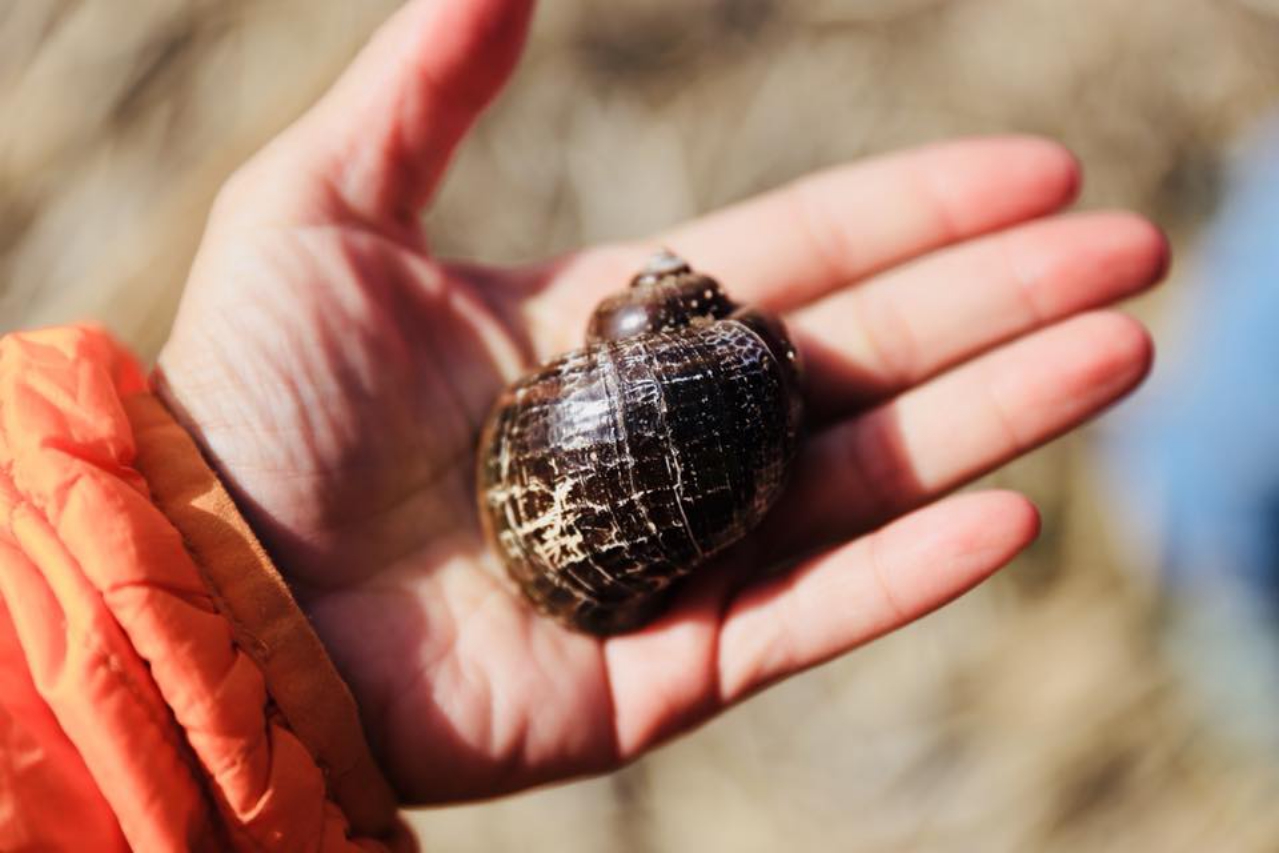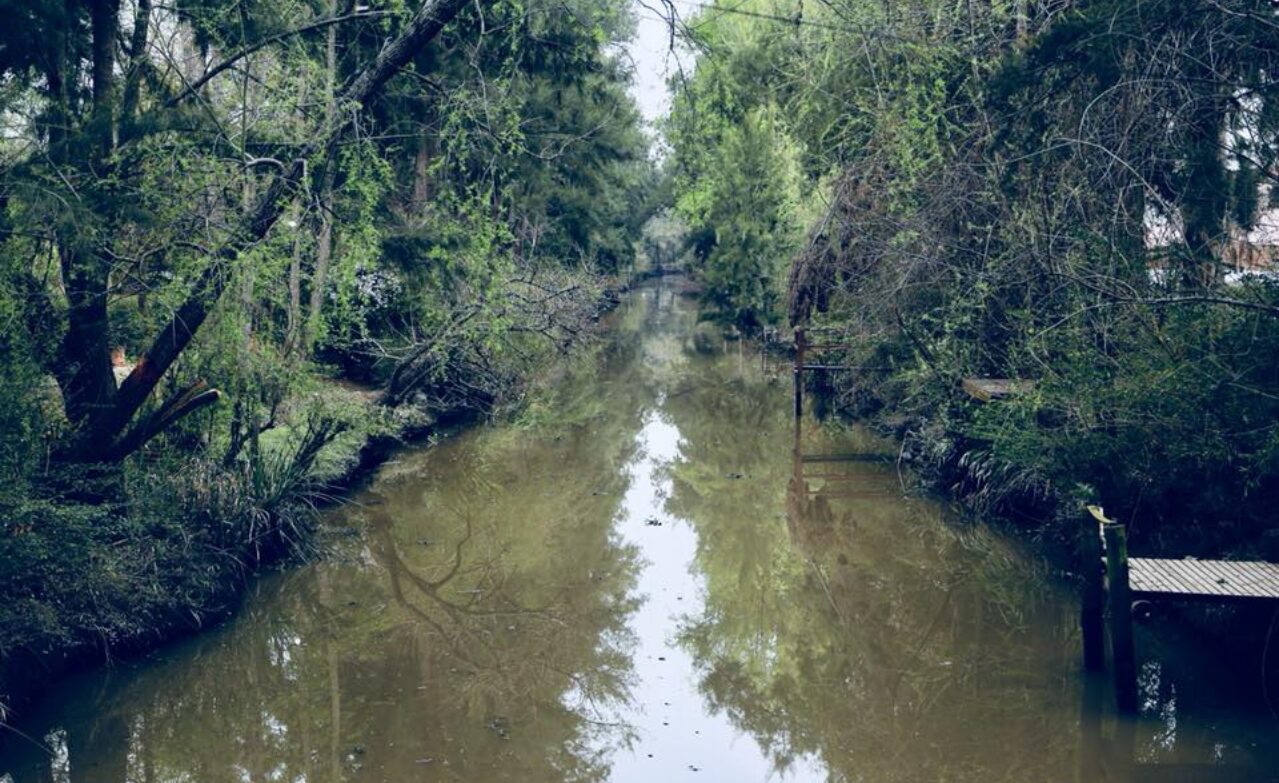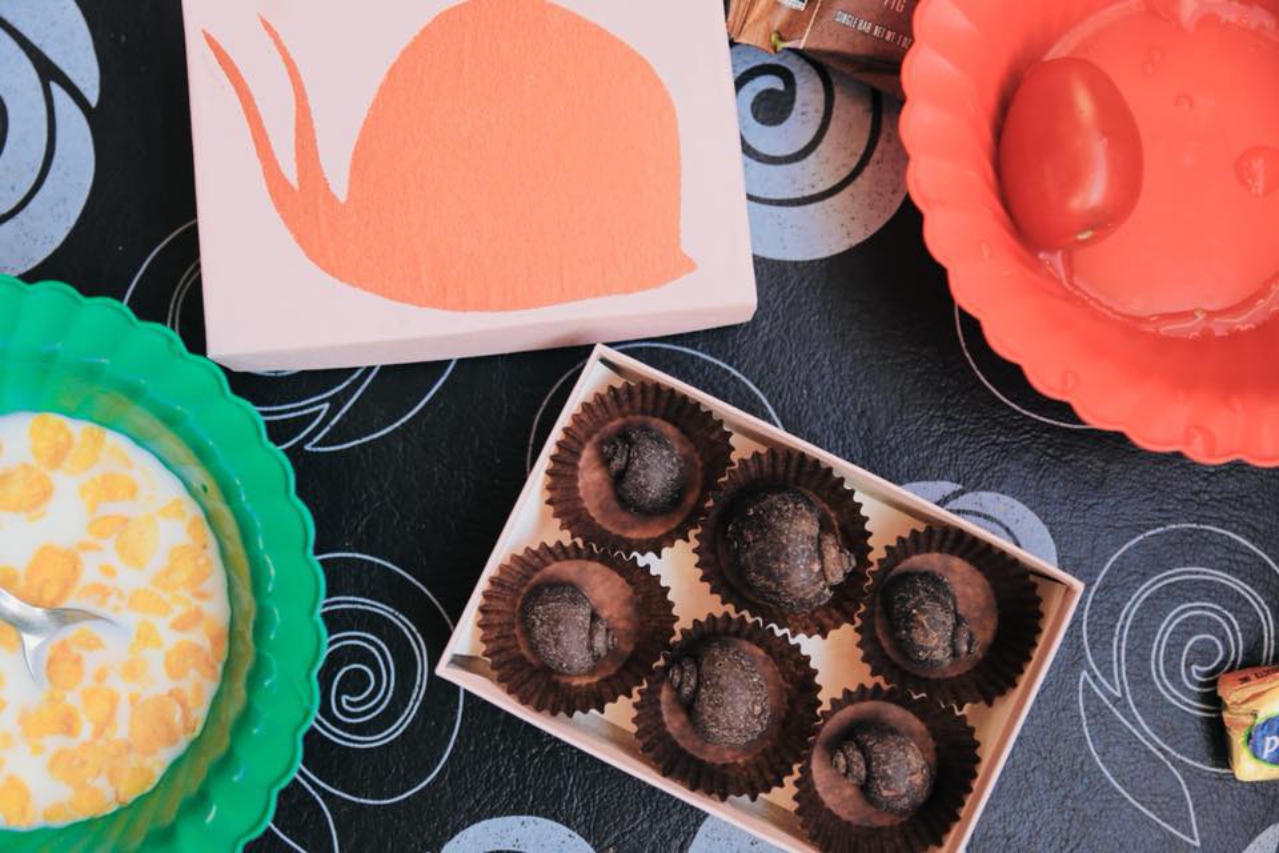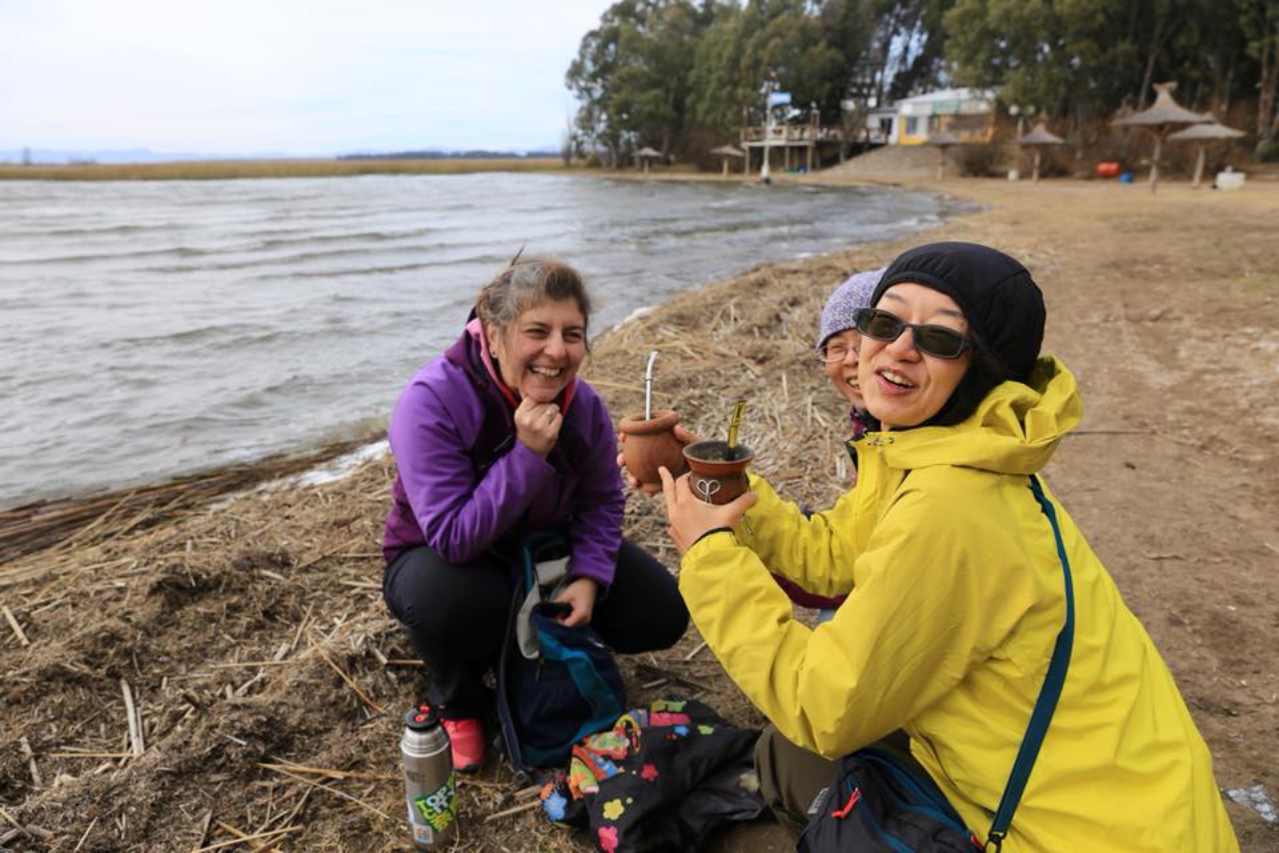Standing by a lagoon in a remote part of Argentina, we shivered in the cold wind while watching the waves lapping at the shores. From time to time, we stepped into the frigid water in search of our prize.
It was an empty shell of a golden apple snail, the common name of Pomacea canaliculata.
It had been a long and arduous journey for us to arrive at the golden apple snail’s original habitat. Setting off from Yilan County, Taiwan, we first took a flight from the Taoyuan International Airport to the Philippines. After an eight-hour layover, we flew twelve hours across the Pacific to Los Angeles for an overnight stay. We then caught a flight across the Americas, landing in Buenos Aires, Argentina, twelve hours later, and hailed a ride immediately to the domestic airport to take a one-hour flight to the port city of Bahía Blanca. From there, it was still 100 kilometers by car to reach the lagoon, also our destination, Laguna Las Encadenadas. We crossed the International Date Line and came to the other hemisphere of Earth, to a land where the seasons and daytime are almost the exact opposite to those of Taiwan, all for our quest for the origin of golden apple snails.
Bahía Blanca holds special significance for the golden apple snail: The aforementioned lagoon, Laguna Las Encadenadas, is located near the species’ southernmost boundary of distribution in Argentina, the native home to the snail. Here in this port city, we got to meet an expert in Pomacea canaliculata.
Our “South America Snail Chasers” team consisted of four members: Anthropologist Yan-Ling is a founding member of Land Dyke, a women-created, gender-friendly agricultural group; ecologist Fang-Yi oversees Science in the Field, a long-term ecological research and management project on Taiwanese farmlands; I am an artist who manages the Facebook Page of Tianbunsia, a Shengou Village-based, independent agricultural news agency, and our assistant, Tsuei-Tsuei. What we have in common is our work and commitment to eco-friendly smallholder rice farming in Yilan.
The golden apple snail is the number one threat against paddy rice farming in Taiwan. Before our trip, we had combated the snails for years, suffering massive losses of crops. The snail had gotten on our nerves more times than we could count. However, as we got to know this unyielding adversary better, out of our frustration grew a strange kind of love, urging us towards this pilgrimage together as a team.
We came to Argentina with several nagging questions on our minds: Under what circumstances did the snails make the long journey to Taiwan? How are golden apple snails like in their natural habitat? Are they also wreaking damage to local crops and environment? What are their natural predators? Why does their growth become so overwhelming and formidable after reaching Taiwan and Asia? With all these concerns, we decided to visit an Argentinian scholar who specialized in the snail, to personally observe local rice-growing practices, and to seek out the snails along the waterways.
Yet, as we stood in the chilly air on the shore of Laguna Las Encadenadas, much of our questions were answered on the spot. The snail didn’t stand a chance there. On its southernmost bio-boundary, of a similar latitude as South Korea, the population of the golden apple snail was kept in check by the sub-zero temperatures in winter. The shells we collected were full of scratch marks, proof of a tough life while they lived. In August, at the tail end of the Argentinian winter, we couldn’t even spot a single living snail.
 Owing to their tough living environment, most Argentinian golden apple snails’ shells looked battered. Photo by Over
Owing to their tough living environment, most Argentinian golden apple snails’ shells looked battered. Photo by Over
As we continued our journey, driving northward from Buenos Aires by the Paraná River, the climate grew warmer. According to our research, this segment of land was also the primary habitat of golden apple snails. After seven hours of travelling, we finally reached Santa Fe, the main producing area of rice in Argentina. Here was also where we experienced the grandest survey of paddy field ever in our lives. Two frog researchers stationed there drove us around the perimeter of the field. It was 20 kilometers in linear distance from the entrance to the other side of the border, spanning an area of 10,000 hectares, a scale beyond our imagination. As if on a safari1, we encountered caimans in the irrigation canals, boa constrictors by the roadsides, and more than a few species of birds of prey, most important of which were the snail kite (Rostrhamus sociabilis) and the limpkin (Aramus guarauna), whose diets consist mainly of golden apple snails.
On the ground, around the wooden stakes that lined the road to serve as the fence, were piles of snail shells. They were all that remained after the birds had feasted on the meat. We realized that golden apple snails form an essential link of the food web of their natural habitat; many animals, from raccoons, snakes, caimans, limpkins, and snail kites, rely on them for sustenance. Without the golden apple snail, the entire local ecosystem might collapse.
 Left: Notebook sketches of snail kites and limpkins. Right: Around the wooden stake, the piles of golden apple snail shells were the testimonies of snail kites’ feasts. Photo by Over
Left: Notebook sketches of snail kites and limpkins. Right: Around the wooden stake, the piles of golden apple snail shells were the testimonies of snail kites’ feasts. Photo by Over
Much data suggest that golden apple snails have no natural predators in Taiwan, but according to growing research and the personal observations made by our resident ecologist Fang-Yi, many indigenous animals of Taiwan, such as the common moorhen, white-breasted waterhen, greater painted-snipe, and yellow pond turtle, have already acquired a taste for the snail. The real issue is the wholesale destruction of the paddy field habitat which broke down the food web, creating an ecological vacuum that provided the snails with an all-you-can-eat buffet, resulting in runaway population increases.
The dry planting method of rice cultivation2 in Argentina is also rather different from the waterseeding one in Taiwan. Here, instead of being planted in submerged paddy fields, seeds were sown into dry soil tilled by machinery. By the time the fields are flooded with water, the rice seedlings have grown, too tough for the snails to chew through. In stark contrast, the water seeding practice in Taiwan creates a haven for golden apple snails, a fertile ground to expand their families.
In different geographical areas, the respective growth states of the golden apple snail are affected by different local food webs and human farming practices. The history of the golden apple snail marks one of mankind’s entangled relationships with other lifeforms. The snail was introduced to Taiwan about 50 years ago. On most Internet resources, it was a linear narrative that “someone” brought the first batch of the snail from Argentina, seeking their fortune in the Taiwanese snail meat market; after it was discovered that the meat did not appeal to the local palate, the snail colonies were discarded and began to spread in the wild.
Most accounts end with this conclusion, then proceeding to criticize the incident as a thoughtless and unforgivable act of selfishness. However, after Yan-Ling traced the past using anthropological field research methods in both Taiwan and Argentina, a three-dimensional narrative began to emerge. Taiwanese people came to Argentina with reason. These immigrant investors fled their home nation, because Taiwan had just been forced out of the United Nations and was experiencing political turbulence. In Argentina, they saw a highly-developed country, free of the ravages of World War II, with abundant land and resources as well as plenty of opportunities to explore.
Once they arrived in Argentina, some of them bought farms to grow mushrooms, vegetables, and bean sprouts, while others opened supermarkets, restaurants, or any kind of viable businesses on a foreign land. Here, where opportunities and failures might appear the same at the first sight, a Taiwanese immigrant went fishing in a nearby river, an hour’s drive from Buenos Aires. He discovered a golden apple snail, and came up with the idea of asking visiting friends and families to smuggle samples back to Taiwan in search of aquaculture possibilities. After all, there was a similar precedent in Pila leopordovillensis, a freshwater mollusk of African origin. In a time when ecological awareness did not generally exist, as it does now, the snail was simply seen as a commodity, a potential food item, and treated as such.
 Santa Fe river basin, near where the first batch of golden apple snails to Taiwan was collected. Photo by Over
Santa Fe river basin, near where the first batch of golden apple snails to Taiwan was collected. Photo by Over
As to why the aquaculture of golden apple snails would proliferate so quickly in Taiwan, Yan-Ling explained that we had to trace back to Meinong, Kaohsiung of the 1970s. At the cusp of Taiwan’s industrial transformation, farming profits were at an all-time low; the heavy burden of farmland taxes combined with diminishing agricultural product income resulted in a decline of the farming villages in Taiwan. Owing to the imported grains from the American aid, the Taiwan Sugar Corporation began to raise pigs on a corporate scale, forcing meat prices to also collapse. At a point in time when the struggling agrarian society in Taiwan was turning into a commercial and industrial one, the aquaculture of golden apple snails became a popular side business for many households.
When someone finally sampled the golden apple snail, discovering that its taste did not meet the expectation, people were becoming aware of how much rice and other cash crops the snails devoured. However, by then it was an unspeakable truth. Golden apple snails were traded from one village to another, and when their notoriety eventually caught up, people threw them out into the waterways. In Taiwan’s expansive network of irrigation ditches and canals, through the floods commonly seen in typhoon season, the golden apple snail spread across the island unchecked.
Due to their vast number, and the increasing use of pesticides in the fields which had wiped out many of their potential predators in the Taiwanese ecosystem, the snails were living and propagating in an ecological vacuum, taking a super priority seat in this heavenly new world, much unlike how it had been in their Argentinian home. None of the pioneering snails that made the initial journey could have foreseen this kind of prosperity. The person whose brainchild initiated this ecological crisis had never even left Argentina, and never personally worked in the snail aquaculture business in Taiwan.
We also came to realize that, for the protagonists of this dark history, this was a difficult story to tell. How could we reopen the dialogue, evoking the true and unpolished memories? For this very reason, I prepared several chocolate gift boxes.
Those were special dark chocolates shaped like golden apple snails, along with pink chocolates shaped like snail egg clusters. It’s one of the ways we imagine the snails may have sneaked past Taiwanese customs officers: mixed and disguised among praline chocolates; tucked inside folded underwear; packed away in opaque canisters.
 Our specially-made chocolate in the shape of the golden apple snail.
Our specially-made chocolate in the shape of the golden apple snail.
 Chatting over a cup of maté tea by the lagoon with a scholar specializing in the golden apple snail.
Chatting over a cup of maté tea by the lagoon with a scholar specializing in the golden apple snail.
Ours was a journey to bring the golden apple snail home. Five decades ago, the snails arrived not of their own will, but nevertheless took roots in Taiwan and prospered. Half a century later, we retraced those first snails’ arduous route to Taiwan. Although we could not bring living snails back to Argentina, we created their likenesses with chocolate, in addition to gift items like snail egg stickers and printed handkerchiefs designed and sold by Tianbunsia.
During our exchange of ideas with local scholars and Taiwanese immigrants, we presented these gifts and explained our view about the golden apple snail issue. We assured them that it’s no longer an unsolvable crisis in Taiwan: There are specialized pesticides and other eco-friendlier ways being developed to deal with the snail overpopulation. Snail-related quips and puns also helped us to introduce farmland ecology to many people in Taiwan. After this explanation, finally, our hosts and interviewees burst into relieved laugh.
Though our visit to the homeland of the golden apple snail has come to an end, our complex relationship with the snails continues. Over the years, we have come to realize that golden apple snails will never fully disappear from Taiwan’s ecosystem. As Fang-Yi frequently says, the step forward is to investigate ways to coexist with the snail through ecological and agricultural strategies.
On our last stop, we finally arrived at the place where golden apple snails were gathered for their first trip to Taiwan, even though the scenery had changed. Around 50 years ago, a species migrated to the farthest corner of the world from its natural habitat, which in turn prompted us to return and visit its homeland. United as a team from various fields, we made an effort to connect interested parties, immigrants, and Argentinian scholars into a cross-Pacific network, spanning between the nearly antipodal Argentina and Taiwan. By doing so, we crossed the biological divide, recounting a shared history created by both humans and snails.